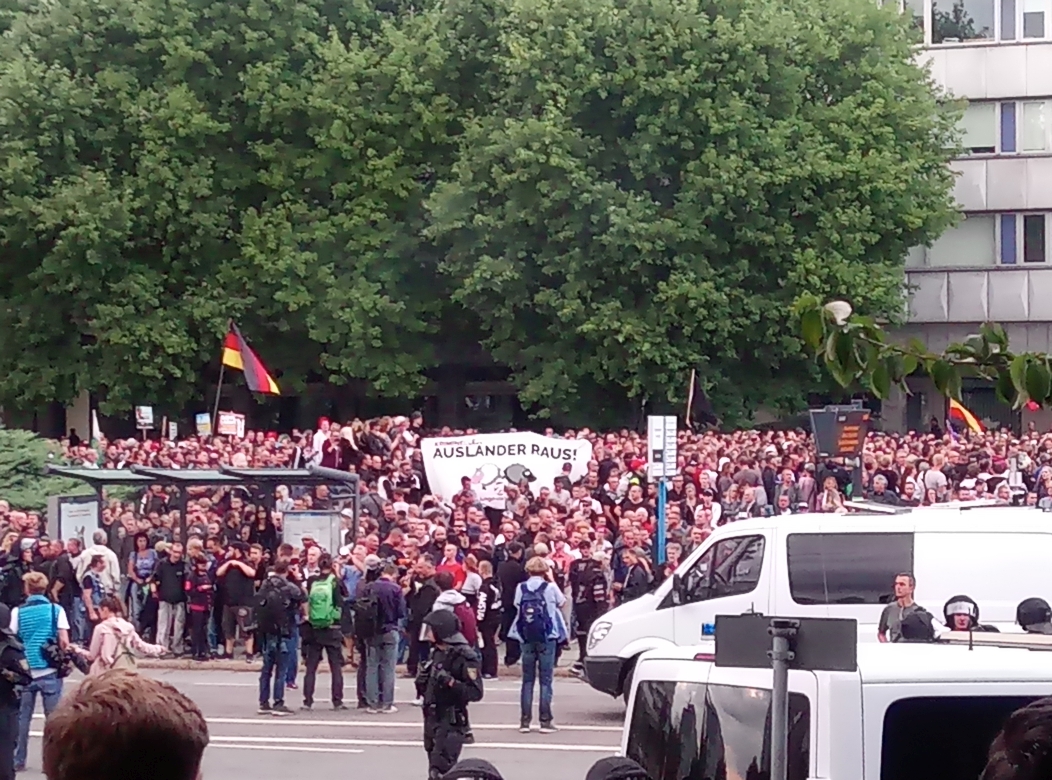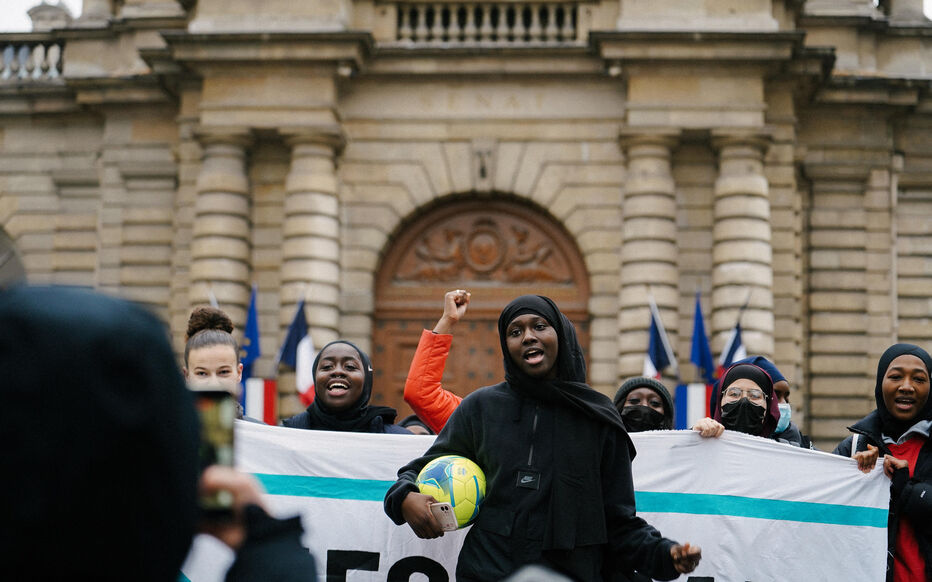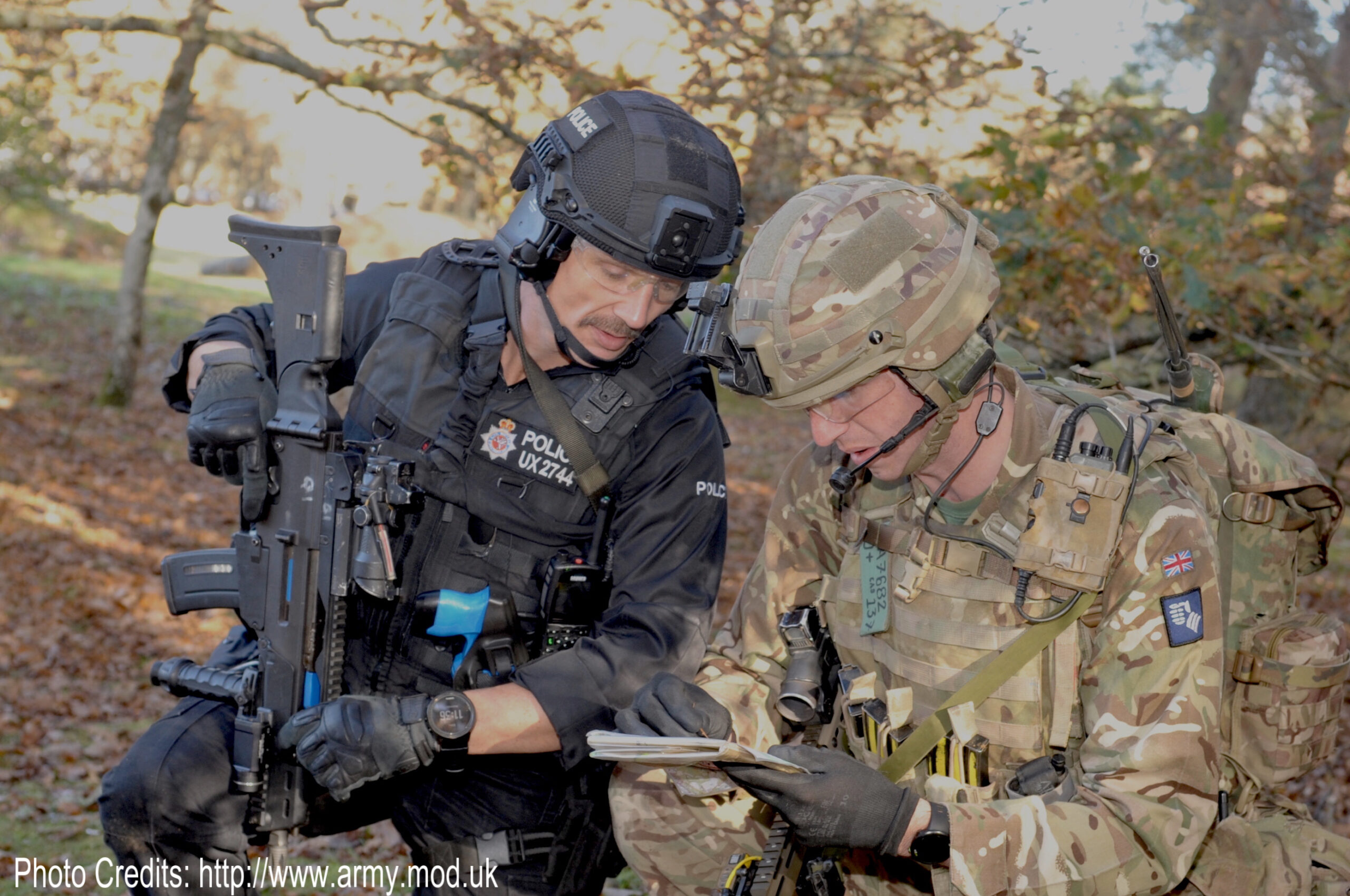The slogan “We are the people!” (Wir sind das Volk!) was one of the iconic protest chants of the 1989 ‘peaceful revolution’. It helped seal the fate of the crumbling regime of East Germany’s Socialist Unity Party (SED), ultimately paving the way for German reunification.
Since 2015, the chant has been heard again; and again predominantly in the former East of the country. This time, however, it has a distinctly ethno-nationalist touch, as it is mobilised to protest the supposed ‘open-door policy’ of Chancellor Merkel vis-à-vis immigrants.
In recent days, the chant reverberated through the streets of Chemnitz, a Saxon city of 250.000 inhabitants. On the side-lines of the town’s annual street festival, a violent individual altercation had left a German citizen dead, with a Syrian and an Iraqi being arrested for his killing. Subsequently, thousands of protestors gathered, shouting xenophobic slogans. Many also sought to act out their notion of an ethnically pure Volk, chasing ‘foreign-looking’ individuals through the city centre. At the end of the day, the reported number of injured stood at 20, including two policemen.
Thousands of far-right activists in the eastern German city of Chemnitz took to the streets to stage violent protests against immigrants and refugees, following the fatal stabbing of a German man. pic.twitter.com/DZOZugxeq0
— CBC News: The National (@CBCTheNational) August 31, 2018
Footage from the demonstrations
A long history of anti-immigrant rioting
The far-right riots in Chemnitz were notable for their scale and for their pogrom-style images of dark-skinned people being chased and attacked on the streets; yet they are by far not the first ones in recent months and years. Most of these episodes have taken place in the state of Saxony in the former East.
Notable events since 2015 have included a xenophobic rampage in Heidenau, as well as a mob surrounding a bus bringing refugees into the small town of Clausnitz. In Bautzen, 80 Germans chased 20 teenage refugees through the streets. (Incidentally, the perpetrators were shouting Wir sind das Volk in these instances.)1
The city of Cottbus, on the Polish border, has been the site of months of ethnic tensions and street fighting.2 And the images coming out of Chemnitz also seem to have emboldened people elsewhere, as reports of attacks on migrants came in from other East German cities.3
The incidents in Chemnitz come on the 26th anniversary of the Lichtenhagen riots, when hundreds of far-right militants terrorised Vietnamese immigrants in the city of Rostock. 3,000 onlookers applauded them as they threw stones and torched parts of the high-rise blocks where the Vietnamese lived.
Bis zu 3000 Zuschauer applaudieren dem Hass, als Rechtsextreme im August vor 26 Jahren ein Wohnheim in #RostockLichtenhagen attackieren. pic.twitter.com/4tTcWUMnVh
— tagesschau (@tagesschau) August 28, 2018
Images from Rostock-Lichtenhagen from 1992
“Many foreigners are afraid here”
Life in Chemnitz had not been easy for those deemed un-German, even before the riots. Speaking to Süddeutsche Zeitung Magazine, a Muslim resident of the city anonymously shared his concerns. While he had never personally feared for his life in Chemnitz, he recounted that “many foreigners are afraid here”. He added:
“People say bad things to me but no one has laid hands on me yet. I don’t even know how you’re supposed to react when you’re attacked by right-wingers – whether you run away or sit down and endure it.”
He also recounted numerous instances of racist insults and discrimination he has faced in the public sphere as well as in the workplace. He nevertheless reported that he had sometimes managed to break through the wall of racist rejection by engaging with the residents and that he wanted to stay in the city.4
“The most important thing is to be cool with it”
A man of Iraqi origin who has lived in Chemnitz for the past six years, was not particularly shocked by the open rioting and the attacks on ‘foreign-looking’ people: “Of course it’s an extreme situation at the moment but you just have to say that I’m used to being accosted on an daily basis. That it’s really going down hard here is not surprising to me.”
Another man agreed that he was often verbally abused in the street but insisted that he had never experienced physical violence.
“The most important thing is to be cool with it and not to let it get to you. Because if you take seriously everything the Nazis tell you, then you fall into a deep hole you won’t be able to leave again.”
He said that when he and his wife visited other German cities like Dortmund and Berlin, they realised that an easier life less marked by constant racist abuse would be possible. “But unfortunately we have a residential obligation [a prohibition to move elsewhere, imposed on refugees] and we can’t just move to other cities.” Reminiscing on their previous situations, however, all three interviewees preferred staying in Chemnitz to being faced with the situation in war-torn Syria or Iraq.5
Demonstrators in Chemnitz chant slogans such as ‘Germany to the Germans, foreigners out!’, ‘Merkel must go!’, and ‘We are the fans, Adolf Hitler, Hooligans’. When they notice the Arab-looking man filming from the window, they insult him and break into a renewed ecstatic chant of ‘Foreigners out!’
Killing of a German-Cuban man
The current wave of unrest started on August 26. During the afternoon, an altercation occurred involving individuals of different nationalities. A Syrian and an Iraqi nationals stand accused of having stabbed to death a 35-year-old German-Cuban man, Daniel H. (German investigators usually do not reveal the last names of victims or perpetrators, for privacy protection concerns.)
As the news of the killing broke – accompanied by a barrage of false rumours – increasingly large crowds of far-right sympathisers gathered almost immediately.
The fact that the far-right should assemble to mourn the victim of the killing does not lack a certain irony: photos of the Daniel H. clearly show a man of partly Cuban heritage. Had he still been alive, he might have been attacked himself for his un-German looks by the mob that was allegedly commemorating his death; and his Facebook profile betrays rather strong left-wing sympathies.6
Muslim barbarians
After his death, however, the 35-year-old could be stylised as the good and pure German hero, slain by the Muslim invaders. Leading AfD politicians stoked this narrative, affirming that Daniel H. was among ‘Merkel’s dead’. This has become a recurrent motif in German politics: whenever a refugee or Middle Eastern migrant commits a crime, in particular an act of rape, manslaughter or murder, this act gets amplified and dominates the national media landscape.
To be sure, no comparable scrutiny exists for cases in which ethnically white perpetrators rape, kill and maim. Yet whenever any respectable news outlet does not accord pride of place to a crime committed by a Muslim man, it is accused of being controlled by political elites who wish to cover up the truth – the inherently violent nature of the Muslim male and politicians’ complicity in unleashing him on the German population.
Fittingly, then, rumour had it that Daniel H. died defending the honour of German women from the rampant sexuality of his Arab killers; a dominant narrative since the sexual assaults of Cologne on New Year’s Eve 2015. Although there is no truth to this assertion, far-right demonstrators in Chemnitz nevertheless held up pictures of battered women at their gatherings. (The pictures actually show US and UK victims of domestic abuse and police brutality.)7
++#Chemnitz ist überall: Welle der Messerkriminalität reißt nicht ab!++
Anstatt die Wahrheit zu berichten, verhöhnen Medien & Altparteien die Opfer, relativieren die Taten & hetzen gg. Bürger, die diese Zustände nicht mehr hinnehmen wollen. Daher #AfD!
ℹ️https://t.co/iR5BWTsZGR pic.twitter.com/Fujot0X9mE— Fraktion der AfD im ???????? Deutschen Bundestag (@AfDimBundestag) August 28, 2018
The AfD party captured all of this in a single tweet reading “Chemnitz is everywhere”: Everywhere Germans are massacred by foreigners wielding knives – and “instead of reporting on the truth, the media and establishment parties mock the victims, relativise the crimes and stir up hate against citizens who no longer want to accept these conditions” – or so the AfD parliamentary group asserted.
Police overwhelmed
For their part, authorities in Chemnitz have struggled to step up to their task. During the following days, police was often unable to provide any kind of check on the successive demonstrations and gatherings that took place in Chemnitz. Federal police from across Germany had to be sent in as reinforcements.
Incompetence was thrown into further relief (and received more sinister undertones) when the arrest warrant for Daniel H.’s killers was leaked to far-right chat groups by an official from a local correctional facility. The chairman of the nationalist, anti-Islam Pegida movement was among the first to publish the warrant online. This not only contravenes German law; it also raises once more the issue of the institutional linkages between Saxon law enforcement and the political far right.
The federal government’s reactions
Political reactions to the events in Chemnitz have betrayed a certain amount of helplessness. The spokesman of the federal government condemned the “riotous assemblies and the hounding of people of different appearance and origins”. Chancellor Merkel echoed these statements.8
The only member of the government who has so far travelled to Chemnitz, however, has been the Federal Minister for Family Affairs, Franziska Giffey. Aside from Angela Merkel, Giffey is the only cabinet member hailing from the former East of the country.
Given the fact that, whenever a representative of the Berlin government makes their way to the state of Saxony, they are usually screamed down by an angry crowd, it was probably surmised that down-to-earth East German Giffey stood the best chances of returning to Berlin without getting a bloody nose. Giffey placed flowers at the site where Daniel H. was killed. (She did not meet with the victims of far-right mob violence – a meeting that, although it might have been desirable, she perhaps did not want to pull off politically.)9
‘Wir schaffen das’, once more
Speaking of the mob violence in the city, Cem Özdemir from the oppositional Green Party called for a “tough response that will be understood in such a way that no questions will remain open. Otherwise, the rule of law will go to rot.”10
By contrast, leading politicians from the Free Democrats (FDP) blamed Chancellor Merkel for the events: “The roots of the riots lie in Chancellor Merkel’s ‘We can do this’”, the party’s vice-chairman Wolfgang Kubicki asserted. ‘We can do this’ (Wir schaffen das) was the Chancellor’s rallying slogan in August 2015 against the backdrop of rising numbers of refugees arriving in the country. It has since become a pivotal statement of her political career.
While Kubicki received some criticism from fellow party members for his stance, others backed him. Overall, the episode illustrates the rightward drift of the former civil rights party FDP. (Recently, party chairman Christian Lindner, comparable to Austrian Chancellor Sebastian Kurz in his self-cultivated image of a stylish and modern conservative, asserted that it was understandable if ordinary Germans were afraid of ‘foreigners’ they encountered in the street.11 )
A weakened civil society
While left-wing counter-movements have sought to mobilise in Chemnitz, they have often been heavily outnumbered by their opponents – a testimony of the weakness of civil society resistance against a far right that has been empowered by the fusion of old neo-Nazi networks with presentable right-wing populism.
Indeed, video footage coming out of Chemnitz seems to signal a broad coalition of groups from various walks of life being involved in the protests. Judging from the occasional Hitler salutes shown and from the chants glorifying National Socialism, there was a hard core of male, hooligan-style neo-Nazis. Yet many women also participated, holding up ‘foreigners out’ banners; and the supporters of the far-right came from all age groups.
In another Brobdingnagian ideological twist, the far-right gathered at Chemnitz’s Karl Marx monument – a bronze sculpture of the philosopher’s stylised head, with an overall height of 13 meters. From 1953 to 1990, Chemnitz was named Karl-Marx-Stadt; and the monument still serves as a symbol of the city. On Monday, September 3rd, some of Germany’s foremost rock bands and hip-hop artists will offer a free concert at the monumebt, seeking to revitalise local opposition and to reclaim the city centre. Yet to combat the rise of the far-right, much more than a single concert will be needed.
Wir sind nicht allein! ❤️❤️❤️
Posted by KRAFTKLUB on Wednesday, August 29, 2018
Rock band Kraftklub advertises the free concert against the far right on Monday.
Sources
https://www.nytimes.com/2018/08/28/world/europe/chemnitz-protest-germany.html ↩
https://www.rbb24.de/studiocottbus/panorama/2018/06/cottbus-auseinandersetzungen-schlaegereien.html ↩
https://www.t-online.de/nachrichten/panorama/kriminalitaet/id_84369378/nach-angriff-auf-syrer-tatverdaechtiger-in-wismar-festgenommen.html ↩
https://sz-magazin.sueddeutsche.de/politik/chemnitz-ist-eine-schoene-stadt-es-gibt-nur-einige-leute-die-bekloppt-sind-86039 ↩
http://www.faz.net/aktuell/politik/inland/chemnitzer-fluechtlinge-der-hass-schlaegt-einem-unverbluemt-entgegen-15766358.html ↩
https://www.berliner-zeitung.de/politik/vereinnahmung-des-opfers-in-chemnitz-wird-daniel-h–zur-politischen-figur-31180424 ↩
https://www.thedailybeast.com/german-neo-nazis-say-these-women-were-abused-by-muslim-immigrants-theyre-actually-american-victims-of-domestic-violence ↩
https://www.tagesspiegel.de/politik/familienministerin-giffey-legt-blumen-fuer-getoeteten-chemnitzer-nieder/22980628.html ↩






